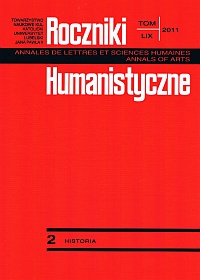Na królewskim dworze Jana Olbrachta
Abstrakt
The article presents Jan Olbracht's (1492-1501) royal Accounts (AGAD, Department 1, catalogue numbers 20, 22, 24, 26,28) as a source for studying the life at the court in the years of this king's rule giving a lot of invaluable information that has not been used in historiography as yet. There are items that show, among others, that Olbracht bought codices, or that he had contacts with Jagiellonian University professors: Piotr of Zambrzecze (died 1497) and Jan Sacranus of Oświęcim (died 1527). The Accounts supply a lot of information about music and entertainment. They say that Jan Olbracht expanded the staff of the royal chapel by employing a chanter and an organist (named Wirowski) and brought excellent musicians to the court, among them being the lutenist Marek, the flutist Kuncza and the trumpeters who were later to play at the royal court of King Aleksander (1501-1506). Four jesters (Bieniasz, Hanusz Ritter, Pecz and Bernard) and a pair of dwarfs (Pieszek and Helena) belonged to the court as well. Also jugglers, bear trainers and swordsmen appeared there. The Accounts also prove Olbracht's inclination to drinking wine and to women. They record a certain Mrs Wolska (may be nee Szydłowiecka) who received costly gifts and a few other women: the noblewoman Zarska, Lady Służewska, Mrs Jadwiga, the townswoman Marta and Miss Jadwiga. In the Accounts there is information about the royal clothes and jewelry. At Olbracht's court's service there were Krakow goldsmiths Stanisław Marcinek and Marcin Marcinek and the armorer Marcin of Nuremberg. We also learn from them about the kinds and colors of costly cloths given as presents and for robes to the members of the royal family, the King's guests and envoys, clerks, courtiers and the court family. The entries in the Accounts also point to cordial relations Jan Olbracht had with his siblings, especially with his brothers, Aleksander and Zygmunt. They show that he upheld the tradition of religious practices, like Władysław Jagiełło (1386-1434) and Kazimierz Jagiellończyk (1447-1492).
Bibliografia
Borkowska U.: Królewskie miłosierdzie, w: Kultura średniowieczna i staropolska. Studia ofiarowane Aleksandrowi Gieysztorowi w pięćdziesięciolecie pracy naukowej, red. B. Gawinowa [i in.], Warszawa 1991, s. 683-694.
Borkowska U.: Polskie pielgrzymki Jagiellonów, w: Peregrinationes. Pielgrzymki w kulturze dawnej Europy, red. H. Manikowska, H. Zaremska, Warszawa 1995, s. 185-203.
Borkowska U.: Rachunki królewskie jako źródło do poznania praktyk religijnych Jagiellonów, w: Peregrinatio ad veritatem. Studia ofiarowane Profesor Aleksandrze Witkowskiej OSU z okazji 40-lecia pracy naukowej, Lublin 2004, s. 47-63.
Borkowska U.: Capella regia w średniowiecznej Europie. (Średniowiecze iwiek XVI), w: Archiva temporum testes. Źródła historyczne jako podstawa pracy badacza dziejów. Księga pamiątkowa ofiarowana Profesorowi Stanisławowi Olczakowi, red. G. Bujak, T. Nowicki, P. Siwicki, Lublin 2008, s. 48-68.
Cracovia Artificum Supplementa. Krakowskie środowisko artystyczne czasów Wita Stwosza, wybr. i oprac. B. Przybyszewski, Wrocław 1990.
Dembińska M.: Konsumpcja żywnościowa w Polsce średniowiecznej, Wrocław 1963.
Olszówka J.: Dwór królewski Aleksandra Jagiellończyka w latach 1501-1506, Lublin 2007, praca doktorska pod kierunkiem U. Borkowskiej, mps Archiwum KUL.
Papée F.: Jan Olbracht, Kraków 1936.
Pietkiewicz K.: Dwór litewski wielkiego księcia Aleksandra Jagiellończyka (1492-1506), w: Lietuvos valstybē XII-XVIII a., red. Z.Kiaupa, A. Mickevičius, J. Sarcevicienē, Vilnius 1997, s.75-131.
Pietrusiński J.: Złotnicy krakowscy XIV-XVI wieku i ich cech, Warszawa 2000.
Turska K.: Ubiór dworski w Polsce w dobie pierwszych Jagiellonów, Wrocław 1987.
Wilska M.: Błazen na dworze Jagiellonów, Warszawa 1998.
Wilska M.: Karły na dworze królewskim – mit czy rzeczywistość?, w: Kościół. Kultura. Społeczeństwo. Studia z dziejów średniowiecza i czasów nowożytnych, red. W. Iwańczak, S.M. Kuczyński, Warszawa 2001, s. 187-200.
Copyright (c) 2011 Roczniki Humanistyczne

Utwór dostępny jest na licencji Creative Commons Uznanie autorstwa – Użycie niekomercyjne – Bez utworów zależnych 4.0 Międzynarodowe.





